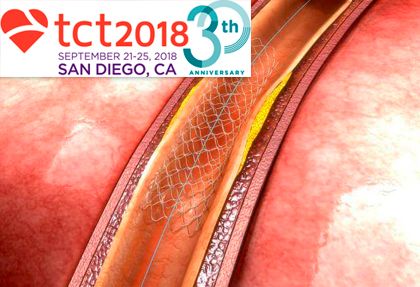Previous studies have documented higher rates of adverse events with bioresorbable scaffolds (ABSORB) compared with metallic drug-eluting stents (DES). However, these studies included lesions smaller than recommended for these scaffolds and a suboptimal implantation technique.
 The ABSORB IV study, presented by Dr. Stone at TCT 2018 and published simultaneously in The Lancet, randomized patients to polymeric everolimus-eluting scaffold Absorb with optimized implantation technique vs. cobalt-chromium everolimus-eluting stent Xience. Patients and clinical evaluators were masked to randomization. The primary endpoint was the classic composite of death, infarction, and clinically-justified revascularization with a non-inferiority analysis.
The ABSORB IV study, presented by Dr. Stone at TCT 2018 and published simultaneously in The Lancet, randomized patients to polymeric everolimus-eluting scaffold Absorb with optimized implantation technique vs. cobalt-chromium everolimus-eluting stent Xience. Patients and clinical evaluators were masked to randomization. The primary endpoint was the classic composite of death, infarction, and clinically-justified revascularization with a non-inferiority analysis.
Overall, 1296 patients were randomized to Absorb and 1308, to Xience.
The primary endpoint occurred in 7.8% of patients who received Absorb and in 6.4% of patients who received Xience, thus achieving the limit for non-inferiority.
Read also: TCT 2018 | RADIOSOUND-HTN: Testing Different Renal Ablation Techniques and Devices.
Definite thrombosis occurred in 0.7% of Absorb patients vs. 0.3% of Xience patients (p = 0.15).
With optimized implantation technique in a barely selected population, Absorb showed that it is still not dead.
Original title: A Blinded Randomized Trial of a Polymeric Everolimus-Eluting Bioresorbable Scaffold in an Expanded Patient Population Using Optimized Technique.
Presenter: Gregg Stone.
Get the latest scientific articles on interventional cardiologySubscribe to our weekly newsletter
We are interested in your opinion. Please, leave your comments, thoughts, questions, etc., below. They will be most welcome.





